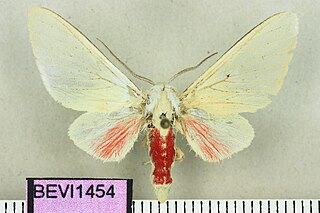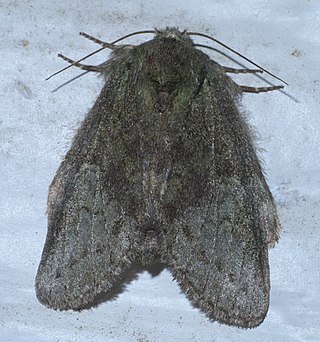
The Callimorphina are a subtribe of woolly bear moths in the family Erebidae. The subtribe was described by Francis Walker in 1865. Many of these moths are easily confused with butterflies, being quite brightly colored and somewhat diurnal. Their antennae are not thickened into "clubs", which is a typical characteristic of butterflies.

Haploa is a genus of tiger moths in the family Erebidae. The genus was erected by Jacob Hübner in 1820.

Apantesis is a genus of tiger moths in the family Erebidae first described by Francis Walker in 1855. They are found in North and Central America.

Haploa clymene, the Clymene moth, is a moth of the tiger moth subfamily - Arctiinae, tribe Arctiini. The species was first described to Western science by Peter Brown in 1776. It is found in eastern North America.
Lambula is a genus of moths in the family Erebidae. The genus was erected by Francis Walker in 1866.

Leptarctia is a monotypic tiger moth genus in the family Erebidae described by Stretch in 1872. Its only species, Leptarctia californiae, was described by Francis Walker in 1855. It is found in western North America, from New Mexico and Colorado to California and north to British Columbia. The habitat consists of open forests, meadows and clearings in the mountains.

Haploa lecontei, or Leconte's haploa, is a moth of the family Erebidae. The species was first described by Félix Édouard Guérin-Méneville in 1832. It is found in North America from Nova Scotia to Georgia, west to Manitoba through Arkansas.

Callosamia angulifera, the tuliptree silkmoth or giant silkmoth, is a moth of the family Saturniidae. It is found in North America from Massachusetts east through central New York, southern Ontario, and southern Michigan to central Illinois, south to the Florida panhandle and Mississippi.
Haploa colona, the colona moth, is a moth of the family Erebidae. The species was first described by Jacob Hübner in 1802. It is found from south-eastern Virginia south to Florida and west to Texas.

Haploa reversa, the reversed haploa, is a moth of the family Erebidae. The species was first described by Stretch in 1885. It is found in North America, from south-eastern Illinois, Iowa, Kansas, New York, Oklahoma and Wisconsin.

Fodina contigua is a moth in the family Erebidae first described by Wileman in 1914. It is found in Taiwan.
Calidota strigosa, the streaked calidota moth, is a moth of the family Erebidae. It was described by Francis Walker in 1855. It is found on the Antilles and from the southern United States to Central America.

Eupseudosoma involutum, the snowy eupseudosoma, is a moth of the family Erebidae. The species was first described by Sepp in 1855. It is found from the southern United States (Florida) to Argentina, as well as on the Antilles.
Hypercompe caudata is a moth of the family Erebidae. It was described by Francis Walker in 1855. It is found in Texas, southern Arizona, Mexico, Costa Rica, Honduras and Nicaragua.
Hypercompe extrema is a moth of the family Erebidae. It was described by Francis Walker in 1855. It is found in Mexico, Costa Rica and possibly Chile.
Phragmatobia assimilans, the large ruby tiger moth, is a moth in the family Erebidae. It was described by Francis Walker in 1855. It is found in North America from Nova Scotia to Connecticut, in the east to British Columbia. There are isolated populations in northern Colorado and the Black Hills of South Dakota. The habitat consists of open meadows and moist forests.

Spilosoma dubia, the dubious tiger moth, is a moth in the family Erebidae. It was described by Francis Walker in 1855. It is found from south-eastern Canada west to Alberta and in the eastern United States. The habitat consists of aspen parkland and southern boreal forests.

Heterocampa umbrata, the white-blotched heterocampa, is a moth in the family Notodontidae described by Francis Walker in 1855. It is found in Florida and coastal Georgia.











